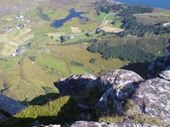
A group of scientists at the Bjerknes Centre for Climate Research and the University of Bergen in Norway, together with colleagues at ETH, Zürich, combined terrestrial and marine proxy palaeo-data covering the latest part of the ice age to improve our understanding of the mechanisms leading to rapid climatic changes.
The Younger Dryas event, which began approximately 12,900 years ago, was a period of rapid cooling in the Northern Hemisphere, driven by large-scale reorganizations of patterns of atmospheric and oceanic circulation. Environmental changes during this period have been documented by both proxy-based reconstructions from sediment archives and model simulations, but there is currently no consensus on the exact mechanisms of onset, stabilization, or termination of the Younger Dryas. In contrast to existing knowledge, the Nature article shows that the climate shifted repeatedly from cold and dry to wet and less cold, from decade to decade, before interglacial conditions were finally reached and the climate system became more stable.
In this study the research team presents high-resolution records from two sediment cores obtained from Lake Kråkenes in western Norway and from the Nordic seas. Multiple proxies from Lake Kråkenes indicate rapid alternations between glacial growth and melting during the second half of the Younger Dryas. Meanwhile, reconstructed sea-surface temperature and salinity from the Nordic seas show corresponding alternations between an extensive sea-ice cover and melting due to the influx of warm, salty North Atlantic waters.
The Nature article suggests that the influx of warm water enabled the westerly wind systems to drift northward, closer to their present-day positions. The winds thus brought relatively warm maritime air to Northern Europe, resulting in rising temperatures and melting of glaciers. However, the resulting input of fresh meltwater into the ocean caused the renewed formation of sea ice, which forced the westerly winds back to the south, cooling Northern Europe again. The research team concludes that rapid alternations between these two states immediately preceded the termination of the Younger Dryas and the permanent transition to an interglacial state.
"We were surprised by the magnitude and the rapidity of the environmental changes during the last part of the Younger Dryas were larger than previously expected, putting the modern term "extreme weather events" in the shade," says the main author Jostein Bakke at the Institute of Geography/Bjerknes Centre for Climate Research.
Journal reference: Bakke et al. "Rapid oceanic and atmospheric changes during the Younger Dryas cold period." Nature Geoscience, Feb 15, 2009; DOI: 10.1038/ngeo439



Reader Comments
to our Newsletter